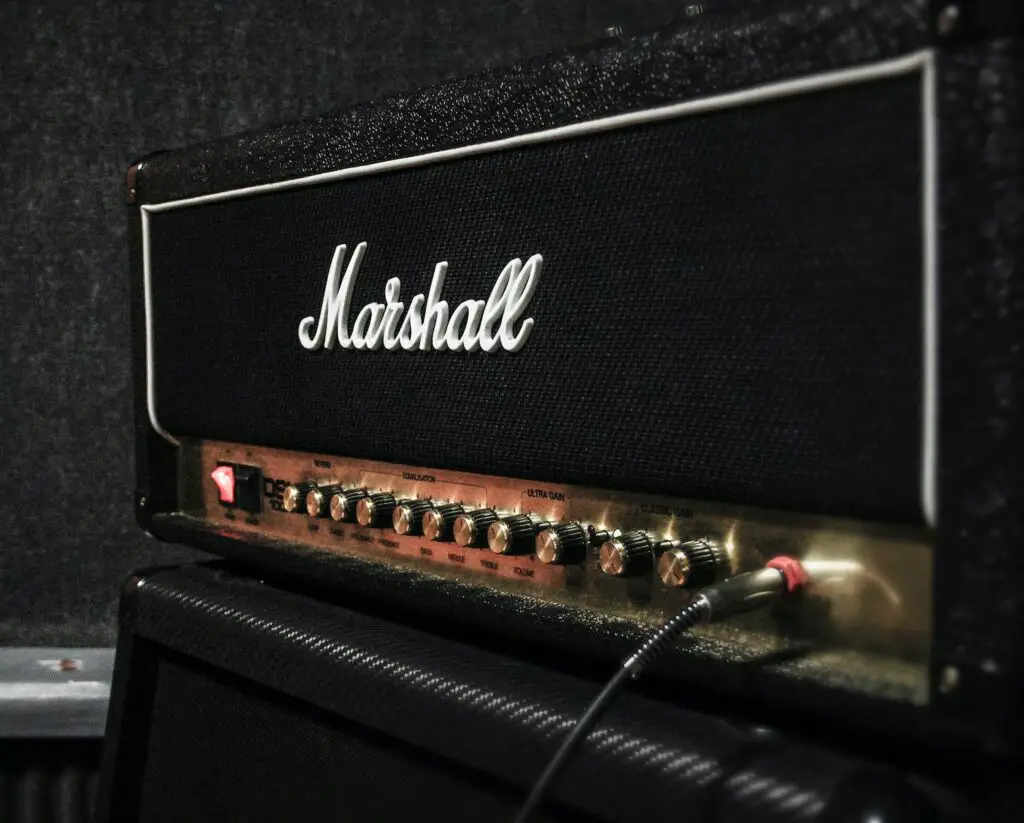The amplifiers serve as a vital component for guitarists to amplify their sound.
Guitar players should carefully evaluate which option aligns best with their requirements when selecting between an amp head and an amp.
While both serve the same basic purpose of amplifying guitar signals, they differ in portability, sound quality, and versatility.
An amp head is simply an amplifier without an integrated speaker, while a combo amp combines both elements for convenience.
Guitarists can create their desired sound using various components with a separate head and cabinet setup.
Understanding the distinctions between amp heads and combos can help guitar players make an informed decision when selecting their gear.
Differentiation between Amp Head and Amp
An amplifier is essential for amplifying the sound of an electric guitar. It may consist of two units – a combo amp or head and speaker working together as one integrated unit.
Conversely, an amp head is simply the component of an amplifier without its cabinet or speaker.
It amplifies the electrical signal produced by a guitar but cannot produce sound on its own; therefore, it must be paired with another speaker or cabinet to generate audio.
An amp head and cabinet setup offers guitarists more creative control over their sound, as they can mix and match different components to achieve the desired timbre.
Professional guitarists typically opt for amp heads for their power, versatility, and superior sound quality.
An amp head may be your best bet if you plan to play larger venues or pursue a professional musical career.
Amp heads provide more power and versatility than amps since they allow the mixing and matching of different parts for customized sounds.
For maximum output, pair a high-wattage head with a 4×12 cabinet for full stack sound; on the other hand, lower-wattage heads can be paired with 1×12 or 2×12 cabinet setups for smaller spaces.
However, if portability is your top priority and setup time is minimal, consider using an ordinary amp instead for better results.
What Is The Function Of An Amplifier Head?
An amplifier head controls the quality and response of a guitar signal. It usually consists of several electronic components, such as preamp tubes, tone controls, and power tubes.
The preamp section amplifies and shapes the guitar signal to achieve the desired tonality, while power amps boost it to levels that can drive speakers effectively.
Conversely, the cabinet is responsible for projecting the sound the head produces and creating the final audio experience audiences hear.
Cabinets consist of one or more speakers housed in either wooden or plastic housings.
The number and size of speakers and the type of wood used in construction can significantly impact sound quality when listening to music from these cabinets.
The head and cabinet combine to amplify and project the guitar’s sound, producing its distinctive tone.
Selecting the correct combination of head and cabinet is key for getting your desired output, whether you’re just starting or an experienced musician.
Can I Play Guitar With Just An Amplifier Head?
When using an amp head, it must be understood that it cannot produce sound independently.
The amp head acts as the core element of any sound reinforcement system, housing both preamp and power amp sections that create tone and amplify guitar signal.
However, without speakers or other loads connected, the head cannot effectively dissipate its power and may suffer serious damage if left uncovered.
It is essential to remember that using a tube amp head without speakers can be highly hazardous. Amps rely on their speaker load to properly balance their output transformer and tubes.
The speaker cabinet is a set of passive speakers that receive amplified sound from the head and project it into your room.
For optimal performance and to prevent damage to components, match the impedance of your speaker cabinet to that of your amplifier head.
Can An Amplifier Head Be Referred To As A Preamp?
An amplifier head is composed of a preamp and power amp section without speakers, serving as the control center for your setup.
It processes guitar signals, shaping and amplifying their tone before being projected through speakers.
The advantage of having a separate amplifier head and speaker cabinet is that it enables guitarists to mix and match different components to achieve their desired sound.
Players can upgrade or replace individual parts as needed rather than invest in an entirely new amplifier.
Notably, this concept of having a separate amplifier and passive speakers is not exclusive to guitar amplification.
Home stereo systems often include separate amplifiers and passive speakers for this purpose.
Is it necessary to have a speaker for the amplifier head to operate?
For an amplifying head to be fully operational, it must have its unit and speaker attached.
It is important to mention that novice guitarists often possess what is commonly referred to as a “basic guitar amp.”
Such an amp usually integrates the amplifier and speaker into a single unit that is housed in a solitary cabinet.
This integrated design simplifies setup but may limit players’ options to customize their sound or upgrade individual components.
By selecting a compatible head and speaker cabinet setup, players can customize their sound to their preferences.
Furthermore, with a separate setup, individual components can be upgraded or changed without impacting other system parts – such as swapping out one head for another or upgrading the speaker cabinet without replacing everything.
As such, many musicians opt for separate head and cabinet setups due to the greater customization it allows.
Matching the impedance of these components is critical for optimal performance and protecting them from damage.
Could You Describe Amp Heads and Cabinets?
A guitar amp head refers to an amplifier without an inbuilt speaker.
To hear the sound produced by this head, it must be connected to a separate speaker cabinet also known as an external cabinet.
Contrary to combo amps, which combine the amplifier and speaker in one unit, guitar players can mix and match different heads and cabinets to achieve their desired sound or upgrade individual components individually.
Beginning guitar players often prefer these setups due to their ease of use and lack of additional components.
These units are often employed in smaller venues with limited space since they occupy less room than a separate head and cabinet.





